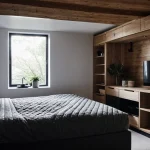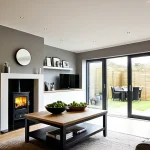Core Home Design Features that Support Pet Well-Being in the UK
Creating a pet-friendly home design in the UK means focusing on elements that promote pet well-being daily. Flooring plays a critical role—durable, scratch-resistant, and slip-proof materials like vinyl or sealed wood are ideal. They ensure pets can move safely without injury while standing up to wear and tear. Avoiding slippery tiles or rugs reduces accident risks, especially for older or energetic animals.
Lighting, both natural and artificial, greatly influences pet comfort. Natural light helps regulate pets’ circadian rhythms and promotes mental health—large windows or skylights encouraging sunlight exposure are beneficial. Complement these with adjustable artificial lighting to mimic day-night cycles, supporting comfort during darker months typical in the UK.
This might interest you : How can you travel safely with your pet across the UK?
The layout of a home must accommodate pet movement and their territorial needs. Open spaces allow dogs to roam freely, while cats benefit from vertical zones offering climbing and hiding spots. Thoughtful placement of furniture and dedicated pet zones prevent conflict and stress, promoting harmony. Such design choices underline how home features for pets can be both practical and nurturing, improving overall quality of life.
Prioritising Safety: Keeping Pets Secure and Comfortable Indoors
Ensuring pet safety begins with secure windows and doors that prevent accidental escapes or injuries, a critical concern in the UK where outdoor hazards and traffic pose risks. Installing sturdy pet barriers in staircases or restricted areas maintains a secure home for pets, allowing controlled freedom without constant supervision.
This might interest you : How can you travel safely with your pet across the UK?
Owners must vigilantly avoid hazards like toxic plants—common species such as lilies and daffodils are dangerous to pets—and ensure dangerous décor or accessible wires are out of reach. These elements commonly lead to poisoning or choking. Regularly inspecting and pet-proofing household items aligns with UK pet-safe regulations that recommend proactive environmental safeguards.
UK animal safety regulations stress the importance of creating a hazard-free indoor environment, advocating for durable materials and barriers appropriate to pet size and behaviour. These laws guide pet owners in minimising risks, ensuring an environment where pets can thrive safely. Adhering to such guidelines enhances pet safety and well-being, providing peace of mind and comfortable surroundings adapted to both pet and owner needs.
Enhancing Pet Enrichment and Mental Stimulation through Design
Helping pets thrive is about more than safety—it requires a stimulating home for pets that encourages natural behaviours. Integrating climbing shelves for cats and designated play areas for dogs fosters physical activity, crucial for pet enrichment. Elevated platforms let cats satisfy their territorial instincts, while open spaces and toys keep dogs mentally sharp.
Access to outdoor views through large windows offers visual stimulation and prevents boredom. Studies show that pets exposed to changing scenery and natural motion display fewer behavioural issues, reinforcing the importance of well-placed window perches or garden views.
Interactive features like puzzle feeders engage pets’ problem-solving skills, promoting long-term mental health pets UK owners value. These enrichments decrease stress and improve overall happiness by stimulating cognitive function.
Designers can enhance these elements by creating specific zones dedicated to rest, play, and exploration within the home. Thoughtful arrangement of such spaces ensures pets enjoy a balance between activity and relaxation, supporting their innate needs. Such home features for pets are tailored to promote mental and physical well-being, making the living environment both safe and lively.
Practical Tips for Pet-Friendly Home Improvements in Britain
Creating a pet-friendly home design UK does not require major renovations; small changes can greatly enhance pet well-being. Installing washable surfaces in high-traffic pet areas simplifies cleaning while reducing allergens. Materials like vinyl or laminate offer durability without sacrificing style.
Adding non-slip mats improves safety by reducing the chance of pet slips, especially on smooth flooring. These mats also provide comfort during play or rest. For UK pet owners seeking easy access outdoors, pet doors tailored to the home’s insulation and security needs offer freedom without compromising safety.
Sustainability matters too, with many owners opting for hypoallergenic materials that reduce irritants for both pets and humans. Natural fibre rugs or organic cotton bedding are eco-friendly and gentle on animals’ skin.
Budget-friendly approaches include using multi-purpose furniture that doubles as pet storage or beds, making the most of limited space. Renters can benefit from removable adhesive hooks and protective covers that don’t damage walls but keep wiring and delicate areas secure.
By integrating these pet home improvement tips, UK pet owners create practical, comfortable homes that nurture pet comfort and health while fitting various lifestyles and budgets.
Prioritising Safety: Keeping Pets Secure and Comfortable Indoors
Pet safety is paramount in creating a secure home for pets. In the UK, this begins with installing secure windows and doors that prevent accidental escapes or injuries. Sturdy pet barriers are essential in staircases or restricted zones to allow freedom while maintaining control, reducing risks without constant supervision.
Avoiding common household hazards is critical for pet safety. Toxic plants like lilies and daffodils are frequent sources of poisoning, while easily accessible wires or dangerous décor pose choking risks. Removing or isolating these items aligns with the need to maintain a hazard-free indoor environment.
UK animal safety regulations provide clear guidance on creating safe homes. These rules recommend durable materials and correctly sized barriers suited to pet behaviour and size, helping owners minimise risks efficiently. By adhering to such standards, owners not only comply legally but create a nurturing space ensuring pet safety and comfort.
Regular home inspections to identify emerging dangers contribute significantly to a safe environment. Such proactive maintenance enhances both pet well-being and owner peace of mind, fostering a trusting, secure atmosphere indoors for all pets.







